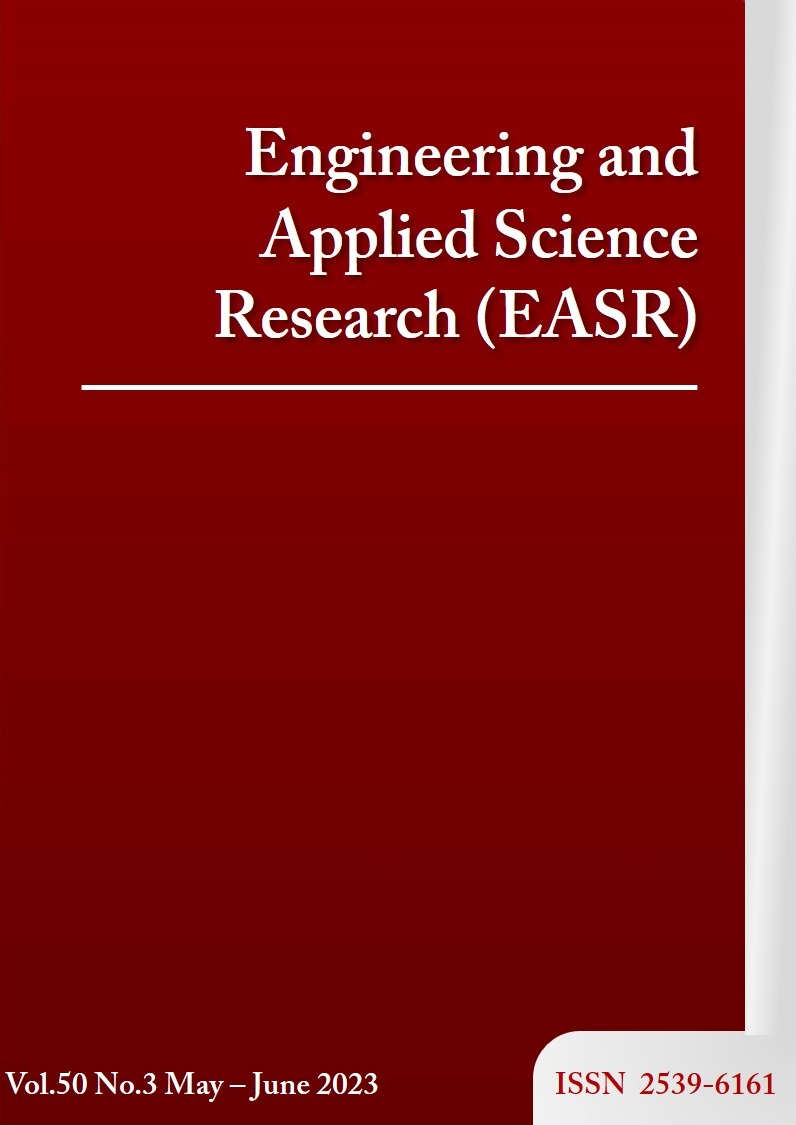A new method to improve raw water turbidity removal efficiency in sedimentation units with continuous discharges and flow recirculation
Main Article Content
Abstract
The CDF method sedimentation tank is a new method that makes a continuous and controlled exhaust flow a new force acting on the particles to be removed, increasing the efficiency of turbidity removal. The exhaust flow, due to continuous and controlled leaks, causes the production capacity of the sedimentation tank to decrease. To maintain the production capacity of the sedimentation tank and to increase the efficiency of the turbidity removal, the effluent due to leakage is recirculated to the inlet of the flocculation tank. The research reactor consisted of a coagulation tank in the form of a waterfall, a flocculation tank in the form of a baffle channel, and a sedimentation tank using the CDF method. The research reactor was designed with a production capacity of 240 L/hour. To test the capability of increasing the production capacity of the sedimentation tank using the CDF method without increasing the number of sedimentation tank units which is referred to as the uprating process, an experiment was carried out in this study by increasing the production capacity to 360 L/hour or 1.5 times the capacity of the original reactor design. The variations in the recirculation of the effluent due to leaking at the bottom of the settling zone to the inlet of the flocculation bath were 0% (no recirculation), 25%, 50%, 75%, and 100% (all effluent recirculated). The results showed that the higher the CDF flow recirculation value, the higher the turbidity removal efficiency. The highest turbidity removal efficiency was achieved at a 100% CDF flow recirculation value which was 87.21% with a treated water turbidity of 3.267 NTU at a design discharge of 240 L/hour, while at a discharge of 360 L/hour, it was 82.50% with a treated water turbidity of 4.528 NTU.
Article Details

This work is licensed under a Creative Commons Attribution-NonCommercial-NoDerivatives 4.0 International License.
This work is licensed under a Creative Commons Attribution-NonCommercial-NoDerivatives 4.0 International License.
References
Liew AG, Ng YM, Noor MJMM. Turbid water clarification using extraction of cowpea seeds. KKU Eng J. 2004;31(2):73-82.
Crittenden JC, Trussell RR, Hand DW, Howe KJ, Tchobanoglous G. Water treatment: principles and design. 3rd ed. New Jersey: John Wiley & Sons; 2012.
Saputri AW. Evaluasi Instalasi Pengolahan Air Minum (IPA) Babakan PDAM Tirta Kerta Raharja Kota Tanggerang. Depok: Teknik Lingkungan Fakultas Teknik Universitas Indonesia; 2011. (In Indonesian)
Putri DTR. Evaluasi Kinerja Instalasi Pengolahan Air Bersih Unit 1 Sungai Ciapus di Kampus IPB Dramaga Bogor. Bogor: Teknik Sipil dan Lingkungan Fakultas Teknologi Pertanian Institut Pertanian Bogor; 2013. (In Indonesian)
Ridwan, Afrianita R, Kurniawan Y. Modification of the sedimentation unit with continuous discharges flow (CDF) as a new method to increase turbidity removal in raw water. And Int J Appl Sci Eng Tech. 2021;1(1):1-9.
Ridwan, Afrianita R. Application of continuous discharge flow (CDF) as new method in the sedimentation unit for removal of raw water turbidity. J Environ Treat Tech. 2020;9(3):698-703.
Gurjar A, Bhorkar M, Bhole AG, Baitule P. Performance study of tube settlers module. Int J Eng Res Appl. 2017;7(3):52-5.
Ridwan, Afrianita R, Gustina, Y. The effect of variation in cone position heigth on raw water turbidity removal in sedimentation unit continuous discharge flow (CDF) method as a new method. Jurnal Ilmu Lingkungan. 2022;20(1):58-64.
Reynolds TD, Richards PA. Unit operations and processes in environmental engineering. 2nd ed. Boston: PWS Publishing; 1996.
Badan Standardisasi Nasional (BSN) Indonesia. Spesifikasi Unit Paket Instalasi Pengolahan Air. Indonesia: BSN; 2014. Report no. SNI.6773:2008. (In Indonesian)
Badan Standardisasi Nasional (BSN) Indonesia. Tata Cara Perencanaan Unit Paket Instalasi Pengolahan Air. Indonesia: BSN; 2014. Report no. SNI.6774:2008. (In Indonesian)
Badan Standar Nasional (BSN) Indonesia. Cara Uji Kekeruhan dengan Nefelometer, Air dan Air Limbah. Indonesia: BSN; 2005. Report no. SNI.06-6989.25. (In Indonesian)
Badan Standardisasi Nasional (BSN) Indonesia. Metoda Pengambilan Contoh Air Permukaan. Indonesia: BSN; 2008. Report no. SNI.6989.57:2008. (In Indonesian)
Sperling MV, Verbyla ME, Oliveira SMAC. Assessment of treatment plant performance and water quality data: a guide for students, researchers and practitioners. London: IWA Publishing; 2020.
Sujarweni W. SPSS untuk Penelitian. Yogyakarta: Pustaka Baru Press; 2014. (In Indonesian)
Achmad C, Alfan P. Kajian Kinerja Teknis Proses dan Operasional Unit Koagulasi-Flokulasi-Sedimentasi pada Instalasi Pengolahan Air (IPA) Kedungguling PDAM Sidoarjo. Jurnal Teknik Lingkungan. 2013;2(2):118-23. (In Indonesian)
Hudson HE. Water clarification processes: practical design and evaluation. New York: Van Nostrand Reinhold; 1981.
Qasim SR, Motley EM, Zhu G. Water works engineering: planning, design, and operation. London: Prentice Hall; 2000.
Kementerian Kesehatan Republik Indonesia. Peraturan Menteri Kesehatan Republik Indonesia No. 492 Tahun 2010 tentang Persyaratan Kualitas Air Minum. Indonesia: Kementerian Kesehatan Republik Indonesia; 2010. (In Indonesian)



